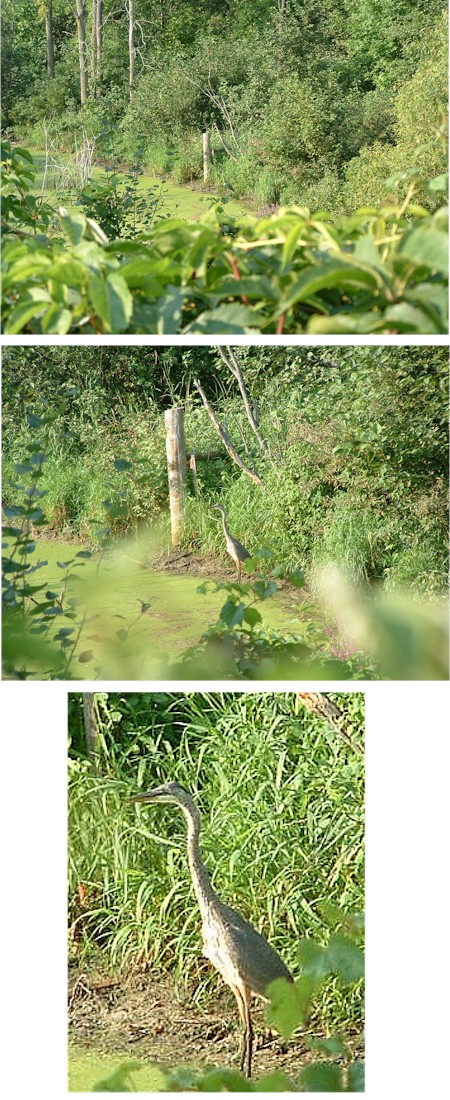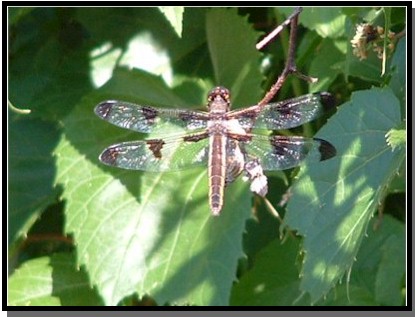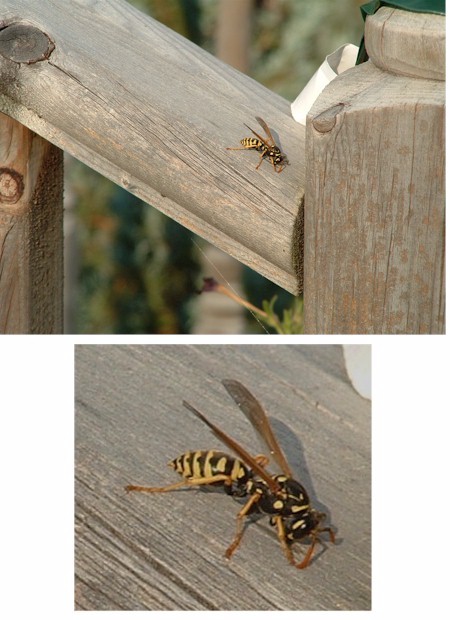| Since I vowed to do so a few months ago, I have been spending about half an hour per day living in the moment — focused, getting outside my head (and away from the PC), learning to pay attention. Some of that time is spent in meditation. Some of it is spent sitting in our indoor hot tub a few feet (through the picture window) from our bird feeders. Some of it is spent at night with Chelsea the dog, out on the back hill, just listening, sniffing, in the dark. And sometimes, as I did yesterday, I take my camera and look carefully, closely, for something to capture on film.
The North Pond connects our back yard to the Albion Hills Conservation Area, and since it is sheltered by trees on all sides it is a popular hangout for shyer wildlife — deer, foxes, birds that shun the feeder, and even occasionally wolves and coyotes. You can pull up a deck chair and peer through the trees unobserved, and if you look closely, and if you are patient, you will often be rewarded. It took a while staring at the scene in the first picture below before I noticed the motionless creature right in the middle of the frame. If you don’t see it, look at the second picture. It was accompanied by a set of three creaking sounds, a song I’d heard before. But it was white! Not a great blue heron, which we’d seen before, but an immature little blue heron, before it gets its remarkable slate-blue feathers and red-brown neck. The full neck extension indicated high alert, and I tried desperately but vainly to catch it on film as it rose magnificently into the air, flapped its enormous, graceful wings, and disappeared into the curve of the pond.
Frustrated by my inability to catch the heron in flight, I started paying attention to other bird movements around the pond. I learned that catching a bird in flight on film is a bit like playing hockey — you need to anticipate when they’re going to fly and also guess correctly where they are going and position your camera there, not where they are currently perched. It took several failures before I finally figured this out — and caught a common tern in flight, below:
|
Navigation
Collapsniks
Albert Bates (US)
Andrew Nikiforuk (CA)
Brutus (US)
Carolyn Baker (US)*
Catherine Ingram (US)
Chris Hedges (US)
Dahr Jamail (US)
Dean Spillane-Walker (US)*
Derrick Jensen (US)
Dougald & Paul (IE/SE)*
Erik Michaels (US)
Gail Tverberg (US)
Guy McPherson (US)
Honest Sorcerer
Janaia & Robin (US)*
Jem Bendell (UK)
Mari Werner
Michael Dowd (US)*
Nate Hagens (US)
Paul Heft (US)*
Post Carbon Inst. (US)
Resilience (US)
Richard Heinberg (US)
Robert Jensen (US)
Roy Scranton (US)
Sam Mitchell (US)
Tim Morgan (UK)
Tim Watkins (UK)
Umair Haque (UK)
William Rees (CA)
XrayMike (AU)
Radical Non-Duality
Tony Parsons
Jim Newman
Tim Cliss
Andreas Müller
Kenneth Madden
Emerson Lim
Nancy Neithercut
Rosemarijn Roes
Frank McCaughey
Clare Cherikoff
Ere Parek, Izzy Cloke, Zabi AmaniEssential Reading
Archive by Category
My Bio, Contact Info, Signature Posts
About the Author (2023)
My Circles
E-mail me
--- My Best 200 Posts, 2003-22 by category, from newest to oldest ---
Collapse Watch:
Hope — On the Balance of Probabilities
The Caste War for the Dregs
Recuperation, Accommodation, Resilience
How Do We Teach the Critical Skills
Collapse Not Apocalypse
Effective Activism
'Making Sense of the World' Reading List
Notes From the Rising Dark
What is Exponential Decay
Collapse: Slowly Then Suddenly
Slouching Towards Bethlehem
Making Sense of Who We Are
What Would Net-Zero Emissions Look Like?
Post Collapse with Michael Dowd (video)
Why Economic Collapse Will Precede Climate Collapse
Being Adaptable: A Reminder List
A Culture of Fear
What Will It Take?
A Future Without Us
Dean Walker Interview (video)
The Mushroom at the End of the World
What Would It Take To Live Sustainably?
The New Political Map (Poster)
Beyond Belief
Complexity and Collapse
Requiem for a Species
Civilization Disease
What a Desolated Earth Looks Like
If We Had a Better Story...
Giving Up on Environmentalism
The Hard Part is Finding People Who Care
Going Vegan
The Dark & Gathering Sameness of the World
The End of Philosophy
A Short History of Progress
The Boiling Frog
Our Culture / Ourselves:
A CoVid-19 Recap
What It Means to be Human
A Culture Built on Wrong Models
Understanding Conservatives
Our Unique Capacity for Hatred
Not Meant to Govern Each Other
The Humanist Trap
Credulous
Amazing What People Get Used To
My Reluctant Misanthropy
The Dawn of Everything
Species Shame
Why Misinformation Doesn't Work
The Lab-Leak Hypothesis
The Right to Die
CoVid-19: Go for Zero
Pollard's Laws
On Caste
The Process of Self-Organization
The Tragic Spread of Misinformation
A Better Way to Work
The Needs of the Moment
Ask Yourself This
What to Believe Now?
Rogue Primate
Conversation & Silence
The Language of Our Eyes
True Story
May I Ask a Question?
Cultural Acedia: When We Can No Longer Care
Useless Advice
Several Short Sentences About Learning
Why I Don't Want to Hear Your Story
A Harvest of Myths
The Qualities of a Great Story
The Trouble With Stories
A Model of Identity & Community
Not Ready to Do What's Needed
A Culture of Dependence
So What's Next
Ten Things to Do When You're Feeling Hopeless
No Use to the World Broken
Living in Another World
Does Language Restrict What We Can Think?
The Value of Conversation Manifesto Nobody Knows Anything
If I Only Had 37 Days
The Only Life We Know
A Long Way Down
No Noble Savages
Figments of Reality
Too Far Ahead
Learning From Nature
The Rogue Animal
How the World Really Works:
Making Sense of Scents
An Age of Wonder
The Truth About Ukraine
Navigating Complexity
The Supply Chain Problem
The Promise of Dialogue
Too Dumb to Take Care of Ourselves
Extinction Capitalism
Homeless
Republicans Slide Into Fascism
All the Things I Was Wrong About
Several Short Sentences About Sharks
How Change Happens
What's the Best Possible Outcome?
The Perpetual Growth Machine
We Make Zero
How Long We've Been Around (graphic)
If You Wanted to Sabotage the Elections
Collective Intelligence & Complexity
Ten Things I Wish I'd Learned Earlier
The Problem With Systems
Against Hope (Video)
The Admission of Necessary Ignorance
Several Short Sentences About Jellyfish
Loren Eiseley, in Verse
A Synopsis of 'Finding the Sweet Spot'
Learning from Indigenous Cultures
The Gift Economy
The Job of the Media
The Wal-Mart Dilemma
The Illusion of the Separate Self, and Free Will:
No Free Will, No Freedom
The Other Side of 'No Me'
This Body Takes Me For a Walk
The Only One Who Really Knew Me
No Free Will — Fightin' Words
The Paradox of the Self
A Radical Non-Duality FAQ
What We Think We Know
Bark Bark Bark Bark Bark Bark Bark
Healing From Ourselves
The Entanglement Hypothesis
Nothing Needs to Happen
Nothing to Say About This
What I Wanted to Believe
A Continuous Reassemblage of Meaning
No Choice But to Misbehave
What's Apparently Happening
A Different Kind of Animal
Happy Now?
This Creature
Did Early Humans Have Selves?
Nothing On Offer Here
Even Simpler and More Hopeless Than That
Glimpses
How Our Bodies Sense the World
Fragments
What Happens in Vagus
We Have No Choice
Never Comfortable in the Skin of Self
Letting Go of the Story of Me
All There Is, Is This
A Theory of No Mind
Creative Works:
Mindful Wanderings (Reflections) (Archive)
A Prayer to No One
Frogs' Hollow (Short Story)
We Do What We Do (Poem)
Negative Assertions (Poem)
Reminder (Short Story)
A Canadian Sorry (Satire)
Under No Illusions (Short Story)
The Ever-Stranger (Poem)
The Fortune Teller (Short Story)
Non-Duality Dude (Play)
Your Self: An Owner's Manual (Satire)
All the Things I Thought I Knew (Short Story)
On the Shoulders of Giants (Short Story)
Improv (Poem)
Calling the Cage Freedom (Short Story)
Rune (Poem)
Only This (Poem)
The Other Extinction (Short Story)
Invisible (Poem)
Disruption (Short Story)
A Thought-Less Experiment (Poem)
Speaking Grosbeak (Short Story)
The Only Way There (Short Story)
The Wild Man (Short Story)
Flywheel (Short Story)
The Opposite of Presence (Satire)
How to Make Love Last (Poem)
The Horses' Bodies (Poem)
Enough (Lament)
Distracted (Short Story)
Worse, Still (Poem)
Conjurer (Satire)
A Conversation (Short Story)
Farewell to Albion (Poem)
My Other Sites









Dave, I just came across this story and thought of you right away.http://news.nationalgeographic.com/news/2005/08/0817_050817_animal_park.htmlWow.
Thanks Lavonne. This is at once fascinating and a bit scary. I can just imagine the ‘businessmen’ selling tickets to big game hunts where fat bored men pay money to slaughter fenced-in elephants. I know that’s not the intent of this program, but I see it as an almost inevitable perversion of it in an economy that values land, life and everything else only for the amount of money that can be made from it.
Great photos, Dave.
Catching insects or birds in flight is a challenge. I think that’s why I prefer making macro images of inanimate objects. :-) I suppose, stretch or atrophy, so pushing oneself is the better course tho. The layout of links done at http://www.followthatstar.com/ might interest you.
Pearl — thanks for the link — that *is* an intriguing layout and a pretty simple change what I have now.
It’s interesting – that’s one thing we need to work on as well, in ourwhite north american society: an appreciation for nature. Last year at an art fair, I saw some sandblasted sculptures created by a native american woman – they resembled natural stone arches, created by erosion in the Southwestern USA.Her art told how she saw motion in rocks. That was the levelshe was on in her conception of what nature was. She sawthe beautiful motions of the elements which created thoserocks over the eons – and the motifs in those things.I think we have to get deeper than just photography. I recentlyheard a radio recording of some speeches of a recent bioneers conference, in my community. I was very impressed – thatis a movement which borders on spirituality, in how theyuse metaphors.
Zephyr: Absolutely. I’m in touch with Kenny Ausubel, leader of the Bioneers, from time to time, and I greatly admire what they’re doing (and Kenny’s writing about it). Some of the art I use in my blog is by Native Americans, and it does add a right-brain dimension that nature photography can’t do as well.
He’s your inspiration, isn’t he? I just found his essay you posted which you found in the Orion journal: “The Empire Strikes Out” – It’s sublime, all the ideas sound in the ears like different musical notes.